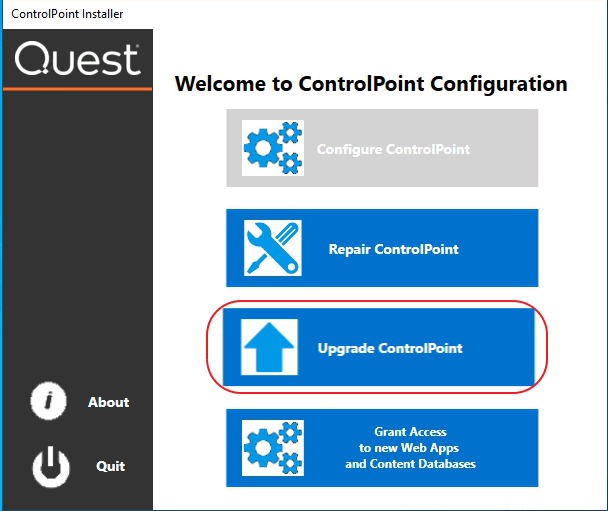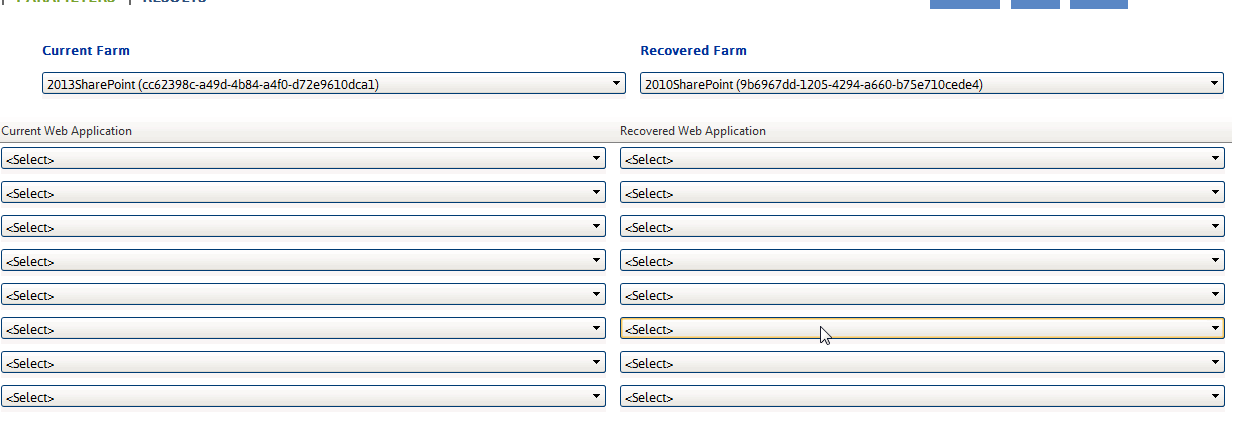Configuring the Environment in Which ControlPoint Will Run
if you have more than one Web front-end server in your farm, once the ControlPoint application has been installed and configured on the first Web front-end server in your SharePoint farm, SharePoint automatically propagates the ControlPoint application to all of them. However, you will need to Configure the ControlPoint application for each additional Web front-end server in your farm, both when installing ControlPoint for the first time and whenever a new Web front-end server has been added to your farm).
You can perform the following tasks as needed:
·If you have not already done so during the installation of the ControlPoint application, manually configure host headers and/or alternate access mappings.
·If you use alternate authentication providers in your farm, configure ControlPoint to recognize them.
IMPORTANT: If the ControlPoint application is to be accessed behind a load balancer, Session Affinity (Sticky Sessions) should be enabled for the ControlPoint Web Application on each server. Otherwise, ControlPoint analyses may fail to complete. (Note that the method for enabling Site Affinity will vary, depending on your load balancer).
REMINDER: Each farm in a multi-farm installation has its own copy of the ControlPoint application. Therefore, if you have installed ControlPoint on multiple farms, you must perform the entire configuration and setup process for each farm.
For information on performing additional ControlPoint configuration and management tasks, refer to The ControlPoint Administration Guide.
Launching ControlPoint
Use one of the following options to start the ControlPoint application.
From your workstation browser:
Enter http://<server_machine_name>:<port_number> or <host_name>/_layouts/axceler/xcMain.aspx.
(The server machine name is the name of the machine on which ControlPoint is installed. 1818 is the default port number for the ControlPoint Web application.)
NOTE: If you are a ControlPoint Application Administrator logging in for the first time, complete the login screen using the account that was designated as the ControlPoint Site Collection Administrator account at the time the ControlPoint application was installed.
From the server on which ControlPoint is installed:
1Log into the server using the account that was designated as the ControlPoint Service Account at the time the ControlPoint application was installed.
2From the Windows Start menu, choose Metalogix > ControlPoint > Launch ControlPoint Application or click the Launch ControlPoint desktop icon.
Upgrading from a Previous Version of ControlPoint
If you are upgrading from an earlier version of ControlPoint, the upgrade process is the same as that for First Time Installation and Configuration, with the following exceptions:
·After installing the new files, you will be given the option to Upgrade ControlPoint.
·The license key, ControlPoint Service (xcAdmin) database, and ControlPoint Configuration site will be retained and updated.
·You will be unable to overwrite the ControlPoint Service Account or connection string.
NOTE: If you need to update the connection string after an upgrade, you can do so via the ControlPoint Configuration Setting SQL Server Connection String for xcAdmin Database (xcAdmin ConnectionString). Refer to the ControlPoint Administration Guide for details.]
Additional caveats depend on the version you are upgrading from, as described in the following table.
|
If you are upgrading from version ... |
Then ... |
|---|---|
|
8.6 or earlier |
if you previously ran Discovery using the SharePoint timer job to run (which has been removed as of version 8.7), you will need to configure the Discovery Service. |
|
8.4 or earlier |
if you are upgrading ControlPoint Sensitive Content Manager Service, version 2.0 or later of Sensitive Content Manager must be also be installed if you want to continue to use it. |
|
8.1 or earlier |
Discovery and Sensitive Content Manager Services will be recreated in the folder C:\Program Files\Metalogix\ControlPoint\ControlPointFeatures\Services, and all settings will be preserved. |
|
8.0 or earlier |
·installed files, which formerly resided in a folder called AxcelerFeature, will be placed in a folder called ControlPoint Features. ·if you installed ControlPoint into an existing Web application, it is no longer necessary to use a separate, scripted installation kit to perform an upgrade. |
Updating the xcAdmin Database After SharePoint Has Been Upgraded via a "Database Attach"
If your SharePoint environment has been upgraded using the "database attach" method, you can use the ControlPoint Database Recovery utility to make data that has been collected in the ControlPoint Service (xcAdmin) database available for use in the upgraded environment. The utility accomplishes this by mapping Farm- and Web Application-level GUIDs in the original environment to those in the upgraded environment.
In order to perform this procedure, Discovery must have been run on both the source and upgraded farms. Instructions can be found in the Quest® ControlPoint Administration Guide.
Data That Can Be Recovered
For any portion of the farm on which the ControlPoint Discovery job has been run, the utility can recover:
·historical information, including site collection storage and activity
·definitions of ControlPoint Policies
NOTE: It will be necessary to re-register those policies, which will enable the event handlers that actually perform the enforcement.
·Group associations used by the Manage (Linked) SharePoint Groups operation.
NOTE: Associated (linked) group will continue to display in ControlPoint, regardless of whether the content database in which they reside has been migrated.
·Information reported in the ControlPoint Task Audit.
·Scheduled ControlPoint operations.
EXCEPTIONS:
§Scheduled jobs to restore permissions will remain but will fail because permissions backups are not recovered.
§Set Site Properties operations will run if the operation includes the setting of icons or theme.
§For Set List Properties operations, the template URL may not be properly reset for the new environment.
§Any job that references content that has not been migrated will fail until that content that has been migrated.
Data That Cannot Be Recovered
The utility will not recover the following:
·User-specific information (such as last temporary location use in Copy/Move operations).
·Permissions backups.
Prerequisites
Before running the ControlPoint Database Recovery Utility, ensure that:
·the upgraded farm has been created
·ControlPoint has been installed and configured on the upgraded farm (with the existing xcAdmin database specified as the ControlPoint Service (xcAdmin) Database)
·The xcAdmin database is accessible to software running on the upgraded farm
·The content databases for which you want to run the utility have been attached and imported
NOTE: If you are attaching content databases in stages, the utility can be re-run as needed. Remember to also run Manage ControlPoint Licenses for newly attached content databases.
·ControlPoint Discovery has been run on all portions of the upgraded farm for which you want to recover xcAdmin data
The utility assumes that if more than one content database is associated with a Web application, those content databases will continue to be associated with the same Web application. If content databases are reorganized or regrouped, the utility will not work properly.
To run the ControlPoint Database Recovery Utility:
1Launch a browser session and enter the following url:
http://<server_name>:<port_number>/_layouts/axceler/xcControlPointDatabaseRecovery.aspx
where <server_name> is the name of either the server you are upgrading to or the server you are upgrading from and <port_number> is the number of the port that hosts the ControlPoint Web application (1818 is the ControlPoint default value).
2From the Current Farm drop-down, select the farm to which content databases have been imported (that is, the upgraded farm)..
NOTE: If the upgraded farm does not appear in the drop-down, make sure that:
§the ControlPoint Service (xcAdmin) database of the old farm has been designated as the Database Server for the upgraded farm, and
§Discovery has been run on some portion of the upgraded farm.
3From the Recovered Farm drop-down, select the farm from which the content databases were imported.
Two sets of drop-downs display, which enable you to map Web applications in the old farm with corresponding Web applications in the upgraded farm.
4For each Web application whose ControlPoint xcAdmin data you want to recover, map the Current Web Application to its corresponding Recovered Web Application.
Note that the Recovered Farm list may include the names of Web applications that no longer exist.
5When you have finished mapping Web applications, click [Run Now].
Note that it may take some time for the progress indicator to appear. When the operation is completed, a ControlPoint Task Audit is generated for the action and displays in the Results section.





